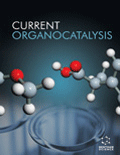- Home
- A-Z Publications
- Current Organocatalysis
- Issue Home
Current Organocatalysis - Current Issue
Volume 12, Issue 1, 2025
-
-
An Efficient and Magnetically Retrievable Mixed Metal Oxide Nanocatalyst for the Aqueous Media Three-Component Synthesis of Naphtho [1,2-e] [1,3] Oxazine Derivatives Under Green Conditions
More LessAuthors: Fatemeh Deldar and Mahnaz Mahdavi ShahriBackgroundIn recent years, the use of nanomaterials as heterogeneous catalysts has attracted much attention in organic reactions.MethodsA magnetically separable mixed metal oxide, Manganese Zinc Iron Oxide (Mn2O3/Fe3O4/ZnO) nanoparticles as nanocatalyst (Mmo@NCt) were synthesized using ultrasonic wave methods in the presence of polyethylene glycol as surfactant. In the second part of the present study, Read More
-
-
-
Multifunctional Deep Eutectic Solvent-Catalyzed Synthesis of Dihydropyrimidinethiones: A Sustainable Approach for Green and Efficient Reactions
More LessBackgroundThis study investigates the synthesis of dihydropyrimidinethiones using a multifunctional deep eutectic solvent (DES) composed of Choline chloride (ChCl) and ammonium thiocyanate. This DES serves as a catalyst, solvent, and reagent, providing a simple, high-yielding, and environmentally friendly method for dihydropyrimidinethione synthesis. The use of DES in this capacity offers several advantages, includ Read More
-
-
-
Green Synthesis of NiO Nanoparticles using Pongamia pinnata and their Catalytic Utility in the Synthesis of N-Fmoc/Cbz-protected Amino Acid Derived Sulfides and their Biological Investigations
More LessAuthors: M. Ramya, H. S. Lalithamba, Dalli Kumari and G. NagendraIntroductionSynthesis of NiO nanoparticles using environmentally friendly Pongamia pinnata seeds as a source of fuel was demonstrated using a solution combustion approach.MethodsThe protocol for the synthesis of NiO NPs is simple and efficient. NiO NPs were utilized as the catalyst for the synthesis of N-protected aminoalkyl sulfides from N-protected alkyl thiols and bromo esters of amino acids.ResultsThe NiO NPs were cha Read More
-
-
-
Phosphine-Catalyzed Asymmetric Allylic Alkylation of Isoxazol-5(4H)-ones with Morita-Baylis-Hillman Carbonates
More LessAuthors: Yuncong Lei, Xuling Chen, Yantong Jiang and Pengfei LiAimsPhosphine-catalyzed asymmetric allylic alkylation of isoxazol-5(4H)-ones with achiral Morita-Baylis-Hillman (MBH) carbonates has been developed. A series of isoxazol-5(4H)-ones bearing all-carbon quaternary stereocenters were obtained in 55-96% yield with 75-90% ee. Gram-scale reaction and further transformation of allylation products were conducted to demonstrate the synthetic practicability.MethodsUnder Ar Read More
-
-
-
Synthesis, In-Vitro and In-Silico Investigation of Pyrazole Derivatives as Anti-bacterial and Antifungal Agents
More LessAuthors: Ankita Bhandari, Nitin Kumar, Anurag Agrawal, Payal Bhatnagar and Shikha SharmaBackgroundHeterocyclic compounds with O, N, and/or S atoms are highly valuable in drug discovery and development. Their pyrazole moieties find applications in various fields, such as herbicides, corrosion inhibitors, electron transport materials, polymers, and luminescent materials. Consequently, there is a pressing need in medicinal chemistry to develop new antibacterial agents to enhance therapeutic efficacy and s Read More
-
-
-
A Novel Synthesis and Quantitation Route of Belinostat
More LessAuthors: Nagarapu Laxmi kumari and Chithaluri SudhakarIntroductionThis research article describes the production, quantification, and purification of Belinostat from 3-nitrobenzaldehyde as the starting material. A cascade-step process produces higher yields when compared to all previous existing methodologies.MethodsThe procedure involved the following: Horner–Wadsworth–Emmons (HWE) reaction of aromatic aldehydes with triethylphosphonoacetate in the presence of pota Read More
-
-
-
Can the Mineralization of Antibiotics from Water Bodies be a Significant Step in the Fight Against Alarming Antimicrobial Resistance?
More LessAuthors: Rashi Bhardwaj, Supradip Saha and Tinku BasuThe overuse and improper disposal of antibiotics may add to the continuous rise of antimicrobial resistance (AMR). In this work, we demonstrate a sequential effect of two novel catalytic systems consisting of MIL-100(Fe) MOF (Metal Organic Framework) and MnO2 nanosheets to degrade amoxicillin antibiotic through the destruction of β lactam group.MethodsThe catalysts were fabricated via chemical method. the catalyst Read More
-
-
-
Biocatalytic Hydroxylation of Progesterone by Penicillium aculeatum
More LessAuthors: Bahman Nickavar and Maryam MehmannavazBackgroundBiotransformation is a powerful process for producing steroid compounds, and fungi are commonly regarded as effective biological agents for this purpose. They facilitate reactions that are difficult to perform via conventional chemical methods.ObjectiveIn the current study, the ability of Penicillium aculeatum to biotransform progesterone was studied.MethodsForty-eight hours after the incubation of active P. acul Read More
-
-
-
An Improved and Efficient Practical Process for the Synthesis of Enantiomerically Pure Solifenacin Succinate as an Antimuscarinic Agent
More LessAuthors: Balkrishna Ramchandra Kale, Hinna Hamid and Mohammad Sarwar AlamBackgroundSolifenacin succinate is an active pharmaceutical drug molecule that is extremely effective in treating overactive bladder symptoms, such as urine incontinence, urgency, and frequent urination. The free base is yellow oil, and the salt solifenacin succinate forms yellowish crystals that are extremely stable and effective. Solifenacin is a very active antagonist due to its potent muscarinic M3 receptor antagonist char Read More
-
Most Read This Month Most Read RSS feed
Article
content/journals/cocat
Journal
10
5
false
en

Most Cited Most Cited RSS feed
-
-
Liquid Membranes in Catalysis
Authors: Muhammad W. Ashraf and M. Amin Mir
-
- More Less

